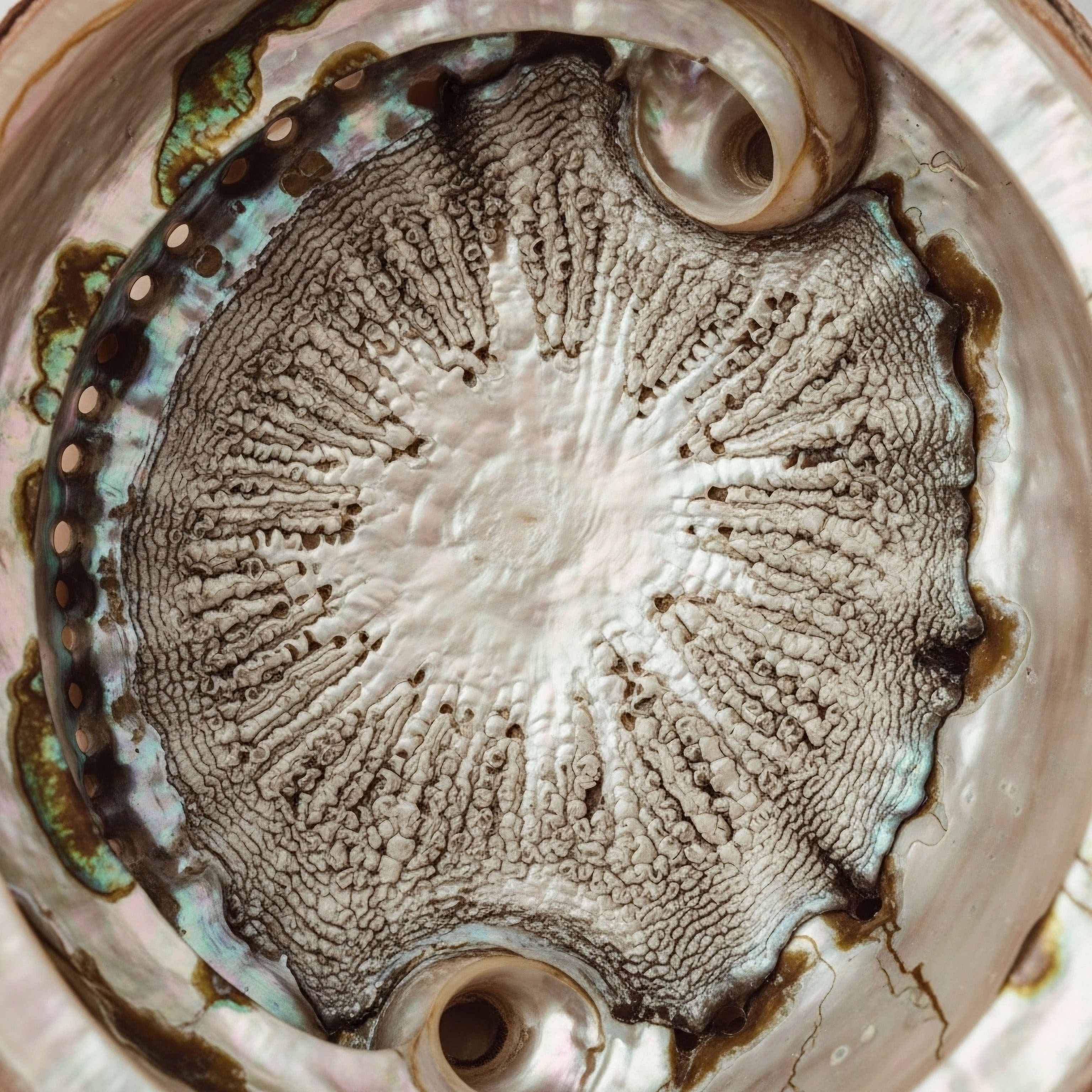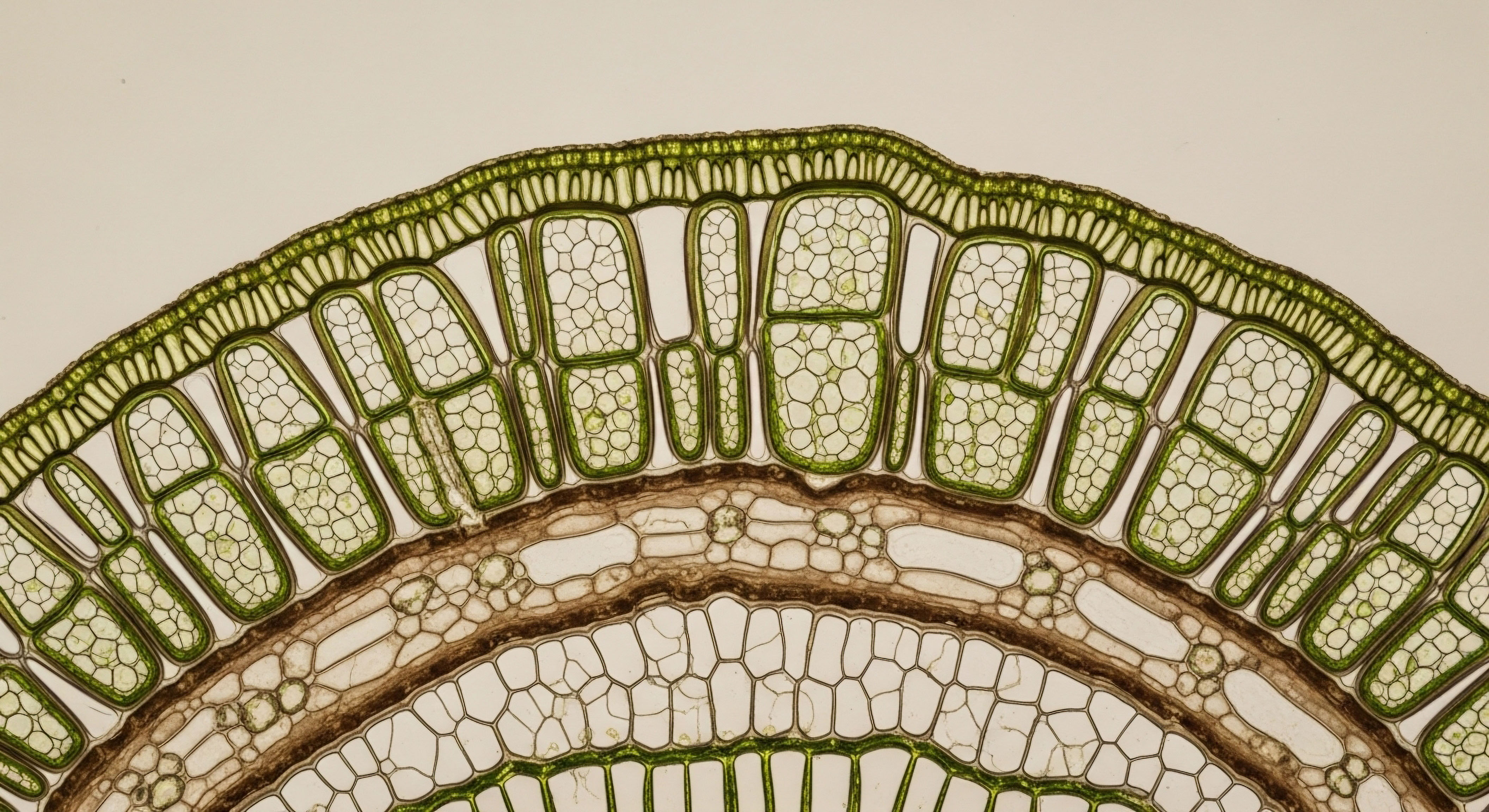

Fundamentals

When Healing Becomes the Hurdle
An injury introduces an unwelcome pause into life. The initial event is sharp and clear, but the recovery period that follows can feel like a frustratingly vague and prolonged process. You follow the standard instructions for rest and rehabilitation, yet progress stalls.
A torn ligament, a strained muscle, or a nagging tendon issue can linger, transforming a temporary setback into a chronic source of limitation and concern. This experience of delayed or incomplete healing is deeply personal.
It affects your ability to work, to engage in hobbies, or simply to move through your day without a constant, low-grade awareness of a weak point in your own body. The body’s repair systems, which normally operate with quiet efficiency, seem to have lost their way, leaving you in a state of suspended animation where full recovery remains just out of reach.
This situation often leads to a search for solutions beyond conventional methods. The question arises ∞ what is missing from the equation? The answer frequently lies not at the site of the injury itself, but within the body’s systemic environment. Healing is not merely a local event.
It is a complex, resource-intensive biological project that depends on a coordinated, body-wide effort. Your endocrine system, the network of glands that produces and regulates hormones, acts as the master controller of this project. Hormones are the chemical messengers that allocate resources, manage inflammation, and give the “go” signal for tissue reconstruction.
When this internal communication system is suboptimal, particularly with age-related declines in key hormones, the entire healing cascade can falter. The local “construction crew” at the injury site lacks the materials and executive direction needed to complete the job.

Peptides as Biological Project Managers
Within this context, peptides represent a targeted intervention designed to restore clear communication and direction to the healing process. Peptides are short chains of amino acids, the fundamental building blocks of proteins. They are not blunt instruments; they are highly specific signaling molecules, each with a precise message for a particular type of cell.
Think of them as specialized project managers dispatched to the site of an injury. While hormones like testosterone or growth hormone provide the high-level, systemic “budget” and “approval” for the repair, peptides get to work on the ground, directing the specific tasks required for reconstruction.
For instance, certain peptides send signals to form new blood vessels, a process called angiogenesis. This is akin to building new access roads to the construction site, ensuring a steady supply of oxygen, nutrients, and cellular building blocks.
Other peptides instruct fibroblasts ∞ the cells responsible for creating connective tissue ∞ to migrate to the area and begin producing collagen, the structural protein that forms the scaffold of new tissue. They can also modulate the inflammatory response, ensuring that the initial, necessary phase of inflammation gives way to the rebuilding phase without becoming chronic and counterproductive.
These molecules work by binding to specific receptors on cell surfaces, delivering a clear instruction ∞ “build,” “repair,” “reduce inflammation.” They do not introduce a foreign function to the body; they amplify and direct the body’s own innate healing intelligence.
The body’s capacity to heal from injury is directly linked to the efficiency of its internal signaling and the availability of systemic resources.

The Systemic Foundation for Local Repair
A crucial concept to grasp is that these peptide “project managers” work most effectively when the overall “company” ∞ your body ∞ is well-funded and organized. This is where foundational hormonal health becomes paramount. An optimized endocrine system ensures that the background biological noise is low and the signals are clear.
For men, this often involves maintaining healthy testosterone levels. Testosterone supports protein synthesis and collagen production, creating a baseline anabolic state that is conducive to repair. For women, a balanced hormonal profile, including appropriate levels of testosterone and progesterone, provides a similar systemic stability that supports all cellular processes, including tissue regeneration.
Protocols designed to optimize these foundational hormones, such as Testosterone Replacement Therapy (TRT) for men or carefully calibrated hormonal support for women, are not just about addressing symptoms of hormonal decline. They are about restoring the body’s fundamental capacity for maintenance and repair.
When this systemic environment is corrected, the introduction of specific peptides for an injury can have a much more pronounced effect. The project managers have the budget, the supplies, and the full support of corporate headquarters. This integrated approach, addressing both the systemic hormonal environment and the specific local signaling at the injury site, offers a more complete strategy for overcoming the frustrations of stalled healing and reclaiming full function.


Intermediate

Key Peptides in the Healing Cascade
When an injury fails to resolve, it is often because one or more stages of the natural healing process have been interrupted. Specific peptides can intervene at these critical junctures to restore momentum. Two of the most well-researched peptides in the context of tissue repair are BPC-157 and TB-500. While often discussed together, they have distinct, complementary mechanisms of action that make them a powerful combination for addressing complex injuries.
BPC-157, a synthetic peptide derived from a protein found in gastric juice, is often described as a “site-specific” healing agent. Its primary strength lies in its ability to accelerate the repair of tendons, ligaments, and muscle tissue, particularly at the site of administration. Its pro-healing effects are driven by several concurrent actions.
BPC-157 promotes angiogenesis, the formation of new blood vessels, by upregulating Vascular Endothelial Growth Factor (VEGF). This enhanced blood supply is critical for delivering repair cells and nutrients to damaged, low-blood-flow tissues like tendons. It also promotes the migration and proliferation of fibroblasts, the cells that synthesize collagen, which is the primary structural component of connective tissue.
TB-500 is the synthetic form of Thymosin Beta-4, a naturally occurring protein that is present in virtually all human cells. Unlike the more localized action of BPC-157, TB-500 exerts a more systemic effect. Its main function is to regulate actin, a protein that is a fundamental component of the cellular cytoskeleton.
By binding to actin, TB-500 promotes cell migration and differentiation, which are essential processes for wound healing. It helps “mobilize” the body’s repair crews, including stem/progenitor cells, to the site of injury. Furthermore, TB-500 has potent anti-inflammatory properties, helping to downregulate inflammatory cytokines and reduce scar tissue formation, leading to more functional and flexible healed tissue.

Comparative Mechanisms of Action
Understanding the different roles of these peptides allows for a more strategic application. BPC-157 acts like a dedicated construction foreman at a specific building site, while TB-500 is the logistics coordinator, ensuring that materials and workers are available and can move freely throughout the entire city.
| Peptide | Primary Mechanism | Key Effects | Best Suited For |
|---|---|---|---|
| BPC-157 | Promotes angiogenesis and fibroblast outgrowth. | Accelerates tendon-to-bone healing, repairs ligaments, muscle tears, and gut tissue. | Localized injuries such as tendonitis, ligament sprains, and muscle strains. |
| TB-500 (Thymosin Beta-4) | Regulates actin, promotes cell migration and differentiation. | Systemic anti-inflammatory effects, reduces scar tissue, improves overall tissue regeneration. | Widespread or chronic injuries, post-surgical recovery, improving flexibility of healed tissue. |

Synergizing Peptides with Systemic Support
While BPC-157 and TB-500 provide direct commands for tissue repair, their efficacy is amplified when the body’s systemic anabolic machinery is functioning optimally. This is where Growth Hormone (GH) secretagogues come into play. A common and effective combination is CJC-1295 and Ipamorelin. This pair of peptides works synergistically to stimulate the pituitary gland to release the body’s own growth hormone in a manner that mimics its natural pulsatile rhythm.
- CJC-1295 is a Growth Hormone Releasing Hormone (GHRH) analogue. It signals the pituitary to produce and release GH.
- Ipamorelin is a Ghrelin mimetic and a Growth Hormone Releasing Peptide (GHRP). It stimulates GH release through a separate pathway and also helps to suppress somatostatin, a hormone that inhibits GH release.
The result of this combination is an elevation of both Growth Hormone and, subsequently, Insulin-Like Growth Factor 1 (IGF-1). IGF-1 is a primary mediator of GH’s effects and is a powerful anabolic factor that promotes cellular repair and growth throughout the body. Using this peptide combination creates a system-wide environment that is primed for healing.
It ensures that when BPC-157 and TB-500 give the command to rebuild, the body has the systemic capacity to respond robustly. This integrated protocol ∞ using GH secretagogues to set the systemic stage and specific healing peptides to direct the local action ∞ represents a comprehensive approach to regenerative medicine.
Effective peptide therapy for injuries often involves combining agents that provide systemic support with those that direct localized repair.

What Are the Implications for Hormonal Health Protocols?
The use of these peptides must be viewed through the lens of an individual’s overall endocrine health. A person with untreated low testosterone, for example, will have a compromised baseline for protein synthesis. Introducing healing peptides in this scenario may be helpful, but its full potential will be blunted. The body simply lacks the foundational anabolic drive to carry out the repair signals efficiently. This is why a comprehensive clinical approach often begins with establishing a proper hormonal foundation.
For a male patient on a TRT protocol (e.g. weekly Testosterone Cypionate with Gonadorelin and an aromatase inhibitor like Anastrozole), the body is already in a state conducive to tissue repair. Adding a cycle of BPC-157/TB-500 for a specific injury can then yield dramatic results.
Similarly, for a female patient whose hormonal balance has been addressed, these peptides can work far more effectively. The peptides do not replace the need for a healthy hormonal environment; they are precision tools that work best within one.


Academic

The Molecular Interplay between BPC-157 and the Growth Hormone Axis
A deeper examination of peptide efficacy in tissue repair moves beyond simple descriptions of healing to the specific molecular pathways being modulated. A particularly compelling area of research is the interaction between the peptide BPC-157 and the Growth Hormone (GH) signaling axis, specifically at the cellular level within connective tissues.
While BPC-157 is known for its pleiotropic effects, its ability to significantly upregulate the expression of the Growth Hormone Receptor (GHR) in tendon fibroblasts is a key mechanism that elevates its therapeutic potential from a simple repair peptide to a sensitizing agent for the body’s master anabolic hormone.
Research published in the journal Molecules demonstrated that when rat Achilles tendon fibroblasts were treated with BPC-157, there was a dose- and time-dependent increase in the expression of GHR at both the mRNA and protein levels. This finding is significant because tendons are notoriously slow to heal due to their poor vascularity and relatively low cellularity.
The density of growth factor receptors in these tissues is a rate-limiting factor for repair. By increasing the number of available GHRs on fibroblasts, BPC-157 effectively makes these critical repair cells more receptive to the circulating GH that is naturally present or augmented through therapies like Sermorelin or CJC-1295/Ipamorelin. This creates a powerful synergistic effect ∞ the systemic therapy (GH release) is made more effective at the local level (the injury site) by the targeted action of the peptide.

Signal Transduction and Downstream Effects
The activation of the Growth Hormone Receptor initiates a cascade of intracellular signaling, primarily through the Janus kinase 2 (JAK2) and Signal Transducer and Activator of Transcription (STAT) pathway. The study on BPC-157-treated fibroblasts confirmed that upon stimulation with GH, the phosphorylation of JAK2 was significantly increased, indicating activation of this downstream pathway.
The activation of JAK2/STAT is critical for mediating GH’s effects on cell proliferation and protein synthesis. The study showed that when BPC-157 pre-treated fibroblasts were exposed to GH, there was a marked increase in cell proliferation, as measured by MTT assay and the expression of Proliferating Cell Nuclear Antigen (PCNA), a key marker of DNA synthesis and cell division.
This molecular evidence provides a clear, mechanistic explanation for the observed healing in animal models. BPC-157 is not just promoting healing on its own; it is priming the tissue to better utilize the body’s most powerful endogenous regenerative signals. This has profound implications for clinical protocols.
It suggests that combining BPC-157 with a GH secretagogue like Ipamorelin/CJC-1295 is not merely an “additive” strategy but a multiplicative one. The Ipamorelin/CJC-1295 ensures a robust, pulsatile release of GH, and the BPC-157 ensures the target tissue is maximally sensitive to that signal.
BPC-157 enhances tissue repair by increasing the density of growth hormone receptors on fibroblasts, thereby amplifying the local anabolic response to systemic growth hormone.

How Does This Affect the Extracellular Matrix?
The ultimate goal of tendon or ligament healing is the organized deposition of a new, functional extracellular matrix (ECM), composed primarily of Type I collagen. BPC-157 also influences this process directly through the activation of the Focal Adhesion Kinase (FAK)-Paxillin pathway.
FAK is a critical signaling protein located at sites of integrin-mediated cell adhesion to the ECM. Its activation is essential for cell migration, survival, and proliferation. Studies have shown that BPC-157 increases the phosphorylation of both FAK and Paxillin in tendon fibroblasts.
This activation promotes the migration of fibroblasts to the injury site and their spreading, which are prerequisites for laying down new collagen fibers. The increased GHR expression and subsequent JAK2 activation work in concert with this FAK-mediated cell migration to orchestrate a comprehensive repair process ∞ the cells are called to the site, they are made more sensitive to growth signals, they proliferate, and they begin the work of reconstruction.

Clinical Considerations and Systemic Hormonal Context
This deep dive into the molecular mechanisms reinforces the importance of a systems-biology perspective. The efficacy of these peptide-driven pathways is inextricably linked to the patient’s underlying hormonal status. Testosterone, for instance, has its own direct effects on collagen synthesis and can influence IGF-1 levels.
A state of hypogonadism would therefore represent a significant headwind to the repair process, even with peptide intervention. Studies have shown that while normal testosterone levels are beneficial for tendon health, supraphysiological levels, sometimes seen in anabolic steroid abuse, can paradoxically alter tendon biomechanics and increase injury risk, possibly by creating a mismatch between rapid muscle growth and slower tendon adaptation.
This highlights the necessity of hormonal optimization, not maximization. A well-managed TRT protocol aims to restore physiological balance, creating the ideal systemic canvas upon which peptides can paint their detailed picture of repair.
The evidence suggests that the most rational and effective approach to significant tissue injury involves a two-pronged strategy ∞ first, establish a balanced and supportive systemic hormonal environment through protocols like TRT or other hormonal support, and second, deploy specific peptides like BPC-157 and GH secretagogues to direct and amplify the healing process at the molecular level.
| Molecular Target | Peptide Action | Downstream Biological Effect | Clinical Relevance |
|---|---|---|---|
| Growth Hormone Receptor (GHR) | BPC-157 upregulates GHR expression on fibroblasts. | Increased sensitivity of repair cells to circulating Growth Hormone. | Provides rationale for combining BPC-157 with GH secretagogues (e.g. Ipamorelin/CJC-1295). |
| JAK2-STAT Pathway | Activated by GH binding to the upregulated GHR. | Promotes fibroblast proliferation and protein synthesis. | Amplifies the anabolic and regenerative signals at the injury site. |
| FAK-Paxillin Pathway | BPC-157 increases phosphorylation (activation) of FAK and Paxillin. | Enhances fibroblast migration and adhesion. | Ensures repair cells can effectively move to and populate the damaged area. |
| VEGF Signaling | BPC-157 promotes the expression of VEGF. | Stimulates angiogenesis (new blood vessel formation). | Improves blood supply and nutrient delivery to avascular tissues like tendons. |

References
- Chang, Chung-Hsun, et al. “Pentadecapeptide BPC 157 Enhances the Growth Hormone Receptor Expression in Tendon Fibroblasts.” Molecules, vol. 19, no. 11, 2014, pp. 19066-77.
- Sikiric, Predrag, et al. “Brain-gut Axis and Pentadecapeptide BPC 157 ∞ Theoretical and Practical Implications.” Current Neuropharmacology, vol. 14, no. 8, 2016, pp. 857-65.
- Hsieh, Ming-Jen, et al. “Therapeutic potential of pro-angiogenic BPC157 is associated with VEGFR2 activation and up-regulation.” Journal of Molecular Medicine, vol. 95, no. 6, 2017, pp. 657-67.
- Chang, Chung-Hsun, et al. “The promoting effect of pentadecapeptide BPC 157 on tendon healing involves tendon outgrowth, cell survival, and cell migration.” Journal of Applied Physiology, vol. 110, no. 3, 2011, pp. 774-80.
- Goldstein, Allan L. and Marion M. Zatz. “The Role of Thymosin β4 in Immune Regulation and Tissue Repair.” Annals of the New York Academy of Sciences, vol. 1351, 2015, pp. 1-14.
- Philp, D. and H. K. Kleinman. “Thymosin beta4 promotes angiogenesis, wound healing, and hair follicle development.” Vitamins and Hormones, vol. 74, 2006, pp. 443-59.
- Raun, K. et al. “Ipamorelin, the first selective growth hormone secretagogue.” European Journal of Endocrinology, vol. 139, no. 5, 1998, pp. 552-61.
- Teichman, S. L. et al. “Prolonged stimulation of growth hormone (GH) and insulin-like growth factor I secretion by CJC-1295, a long-acting analog of GH-releasing hormone, in healthy adults.” The Journal of Clinical Endocrinology & Metabolism, vol. 91, no. 3, 2006, pp. 799-805.
- Herbst, K. L. and S. Bhasin. “Testosterone action on skeletal muscle.” Current Opinion in Clinical Nutrition and Metabolic Care, vol. 7, no. 3, 2004, pp. 271-77.
- Bhasin, S. et al. “The effects of supraphysiologic doses of testosterone on muscle size and strength in normal men.” The New England Journal of Medicine, vol. 335, no. 1, 1996, pp. 1-7.

Reflection

Recalibrating the Body’s Blueprint
The information presented here offers a view into the intricate biological conversations that dictate the pace and quality of your recovery. Understanding these mechanisms ∞ the systemic hormonal backdrop, the specific signals of peptides, and their molecular interactions ∞ shifts the perspective on healing.
It moves away from a passive state of waiting and toward a proactive process of biological recalibration. The human body possesses a remarkable blueprint for repair. The challenge, often compounded by age and injury, is ensuring all levels of the organization have the resources and clear directives to execute that blueprint flawlessly.
Considering your own recovery journey, where might the communication be breaking down? Is the foundation solid, or does the entire system require support before the specific site of injury can be addressed? This knowledge is a starting point for a more informed dialogue, not just with a clinician, but with your own physiology.



